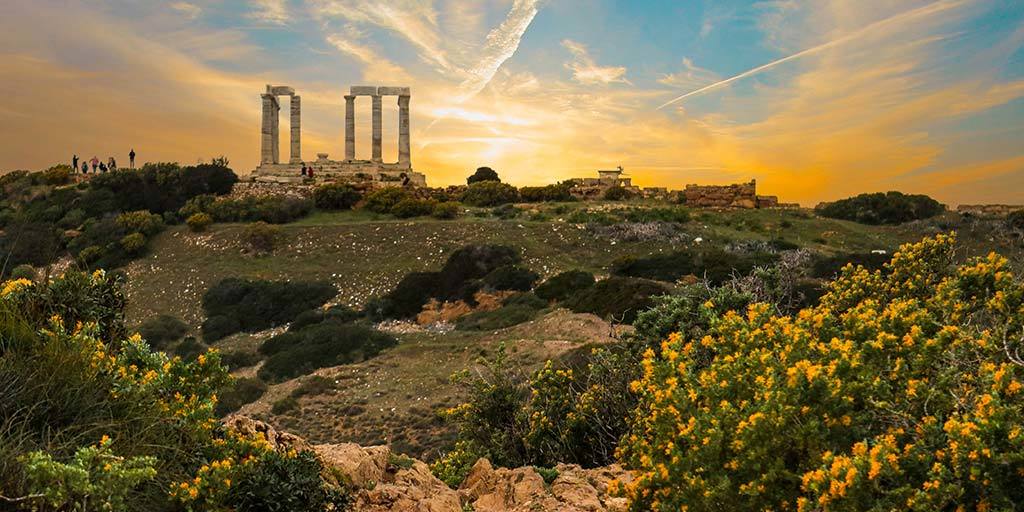Discover the ancient marvels of the Mycenae Lion Gate and the ruins of Mycenae on a family adventure from Athens to Nafplio. Uncover the rich history of the Mycenaean civilization, explore the legendary site that inspired the tales of the Trojan War, and ignite your kids’ imaginations with Greek mythology.
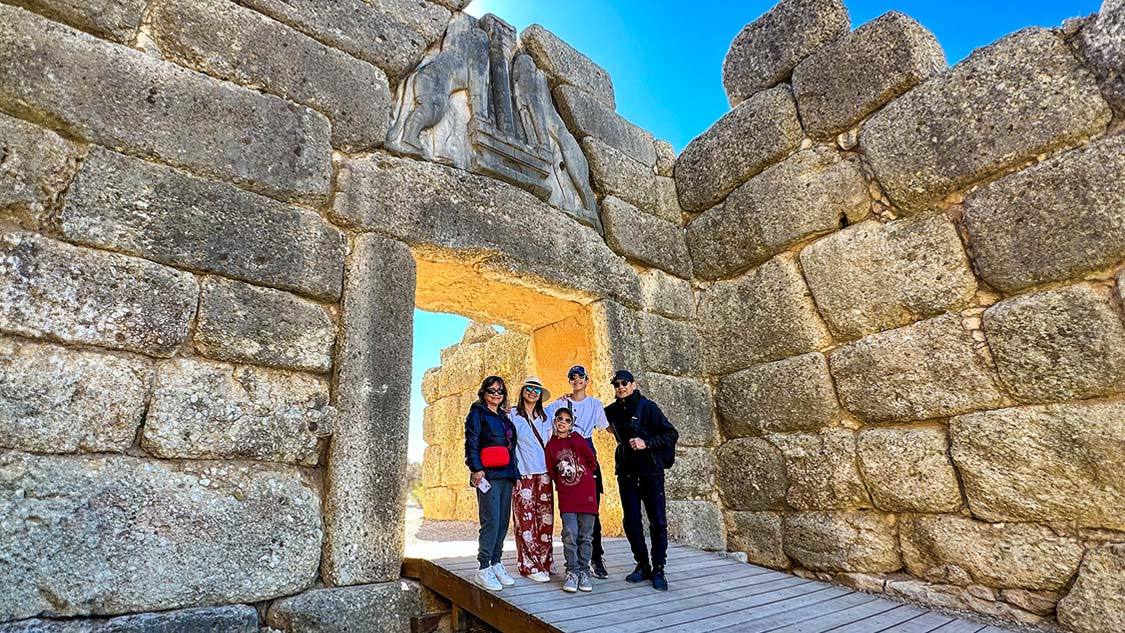
After leaving Athens, my family journeyed west. Our two days in Athens and side-trip to the Temple of Poseidon had been an awe-inspiring glimpse into the history of Greece. But we wanted to dive even further back in time,
We were heading from Athens to the port town of Nafplio via the Corinth Canal, but on our way, we had a very important stop to make. A rock-strewn hill that launched one of the greatest tales of the Classical World and is now one of the coolest places for families to visit in Greece.
This hill and the Mycenae civilization that it spawned was built about a thousand years before the Acropolis in Athens. This Mycenae civilization lasted for about four hundred years, between the 16th and the 12th centuries BCE, and grew to be one of the most powerful empires of its time.
Mycenae was the center of that culture, and it was here that the orders went out to launch the infamous attack on Troy that set the stage for the Trojan War.
After all, it was Greek mythology that got our kids excited about our road trip through the mainland. And this city played a big part in Homer’s telling of the Iliad. So, let’s see how deep we can take this journey.
Why Did We Visit Mycenae?
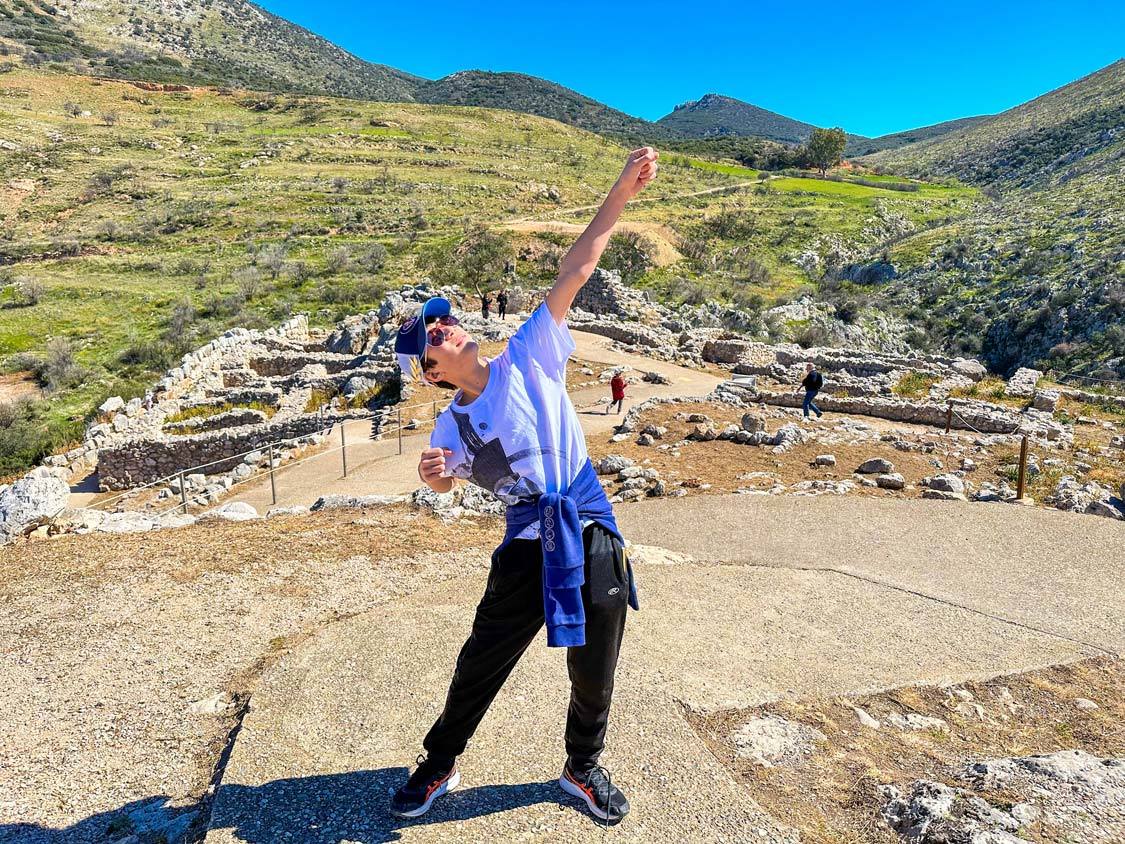
The boys, Cohen and Dylan, spent most of the previous year obsessed with the storyline of Percy Jackson and the Olympians. This book series about demi-God teens living in a modern world where Greek mythology is very much a part of everyday life had them begging Christina and me to bring them to Greece for some adventure.
Anyone who has followed our family travels in the past knows that Christina and I never shirk a chance to combine education with adventure, so we got to planning an unbelievable week-long road trip through mainland Greece that would let us experience some of the country’s most beautiful places to visit and learn a LOT about Greek history along the way.
What’s wild about Mycenae is that it was actually believed to be a FICTIONAL town that had been made up by Homer for his legendary tale. That was until Greek archaeologist Kyriakos Pittakis cleared the Mycenae Lion Gate in 1841. The rest of the excavations of the city didn’t occur until 1874!
The Coolest Things We Saw During Our Visit To The Mycenae Lion Gate
The ancient city of Mycenae is located up a long, gravel road at the top of the Peloponnese peninsula. We were fresh from the road, having stopped earlier at the Corinth Canal for some kebabs and scenic views.
But after getting out, the first thing that we all had to experience were the washrooms. And I don’t mean Agamamnon’s Chamber Pot, which IS one of the most unique things to see in Mycenae, but actual modern flush toilets, which thankfully were available to us visitors.
The Lion Gate at Mycenae
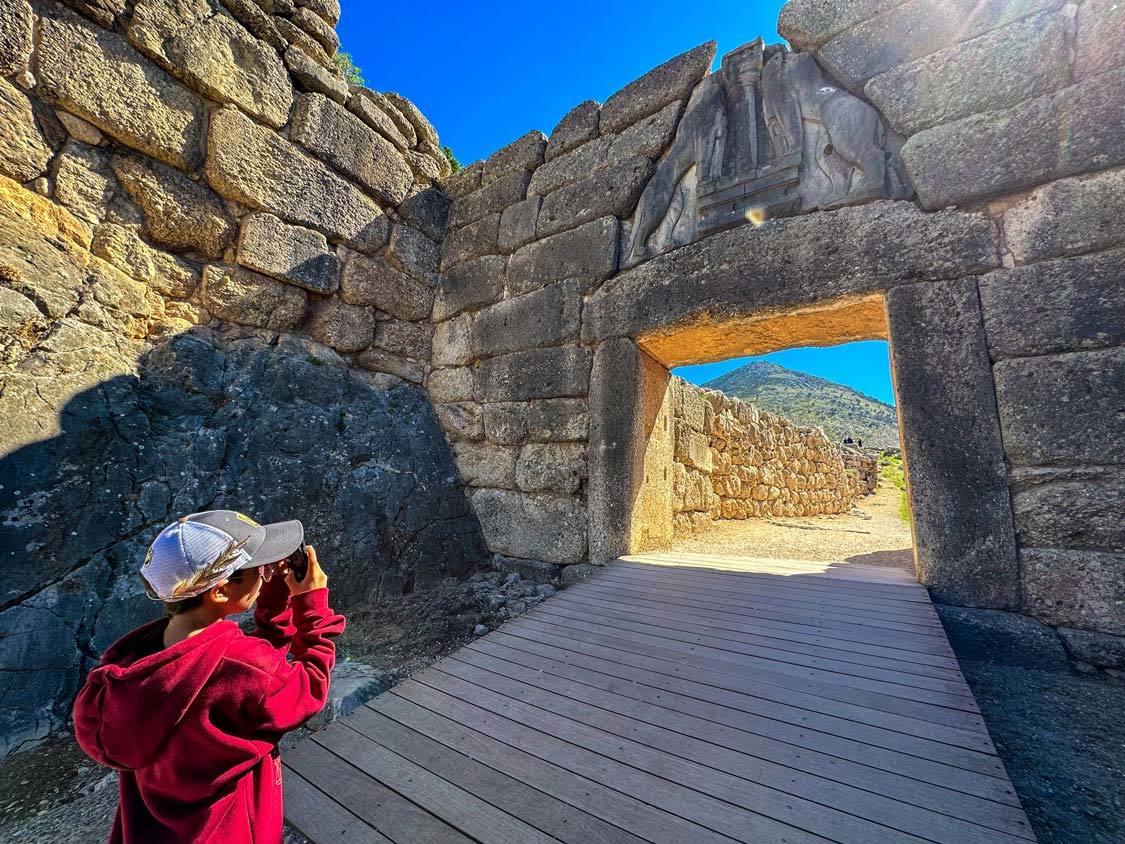
After all six of us were relieved from the long drive, we wanted to kick off our travels to Mycenae with a stop at the archeological site’s most famous attraction, the Lion Gate. And it did not disappoint.
The Lion Gate is the main entrance to the fortified walls of the city of Mycenae. It’s built with massive stones that frame a 10-foot wide and 10-foot high entrance topped by a triangular sculpture featuring two majestic lions with their feet resting on an altar, looking up at a towering column.
It’s believed that the lions originally had metal heads, but these were stolen from the site a long time ago.
The gate is incredibly impressive, especially when we remember that it is more than 3,400 years old. In the afternoon sun, it was beautiful to see how the inside of the gateway had a golden glow from the sun. Everyone in our family wanted their own photo with this beautiful glowing entrance in the background, but shockingly, most other visitors just strolled past the Lion Gate like it was a footnote.
Cyclopean Walls
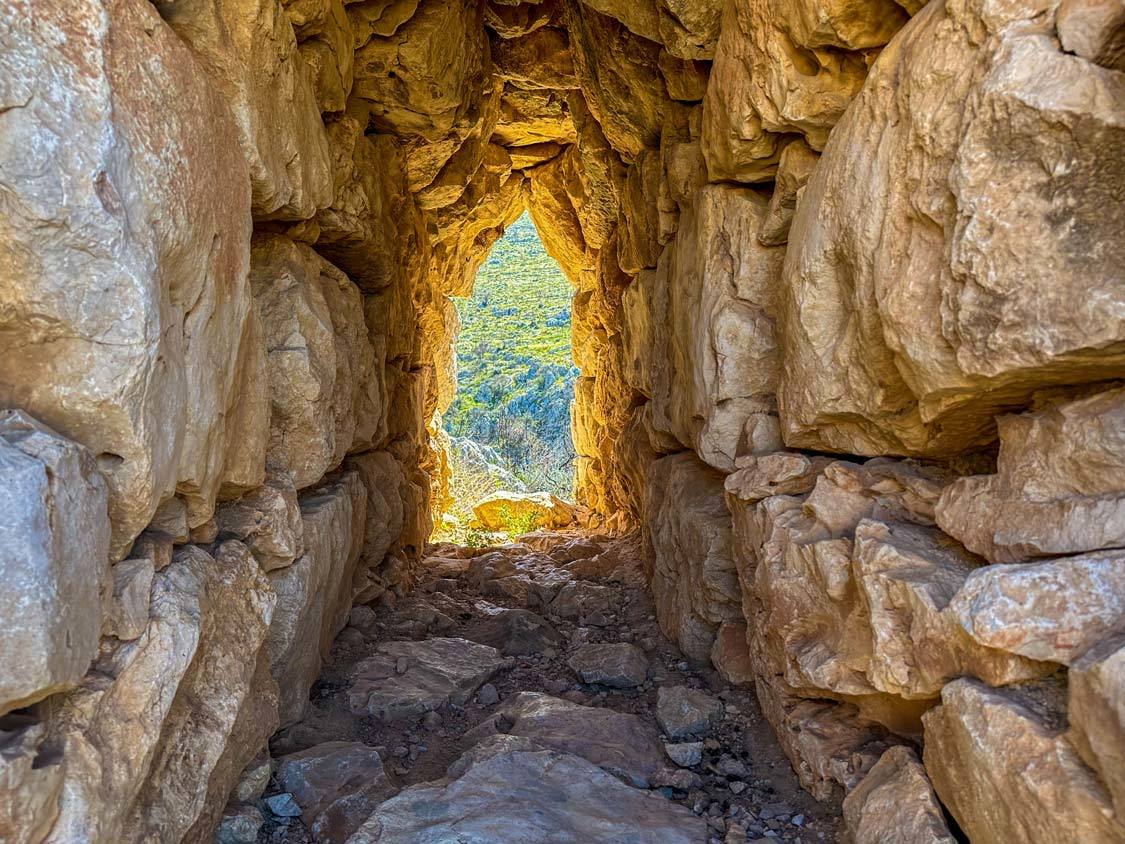
One of the most awe-inspiring things to see at the Mycenae ruins was a roughly-placed line of huge limestone boulders. These stones are part of a massive series of fortified walls known as the Cyclopean Walls. The stones are so big that, in ancient times, many people believed that they could have only been placed there by the mighty Cyclops.
As we walked along the walls, the boys spent time debating how it would have been possible to get these immense stones into place over three thousand years ago. They’ve seen some pretty impressive ancient structures, including the 12,000-year-old Gobekli Tepe in Turkey and the gorgeous ruins of Machu Picchu in Peru, and things like this still blow their minds.
Palatial Complex
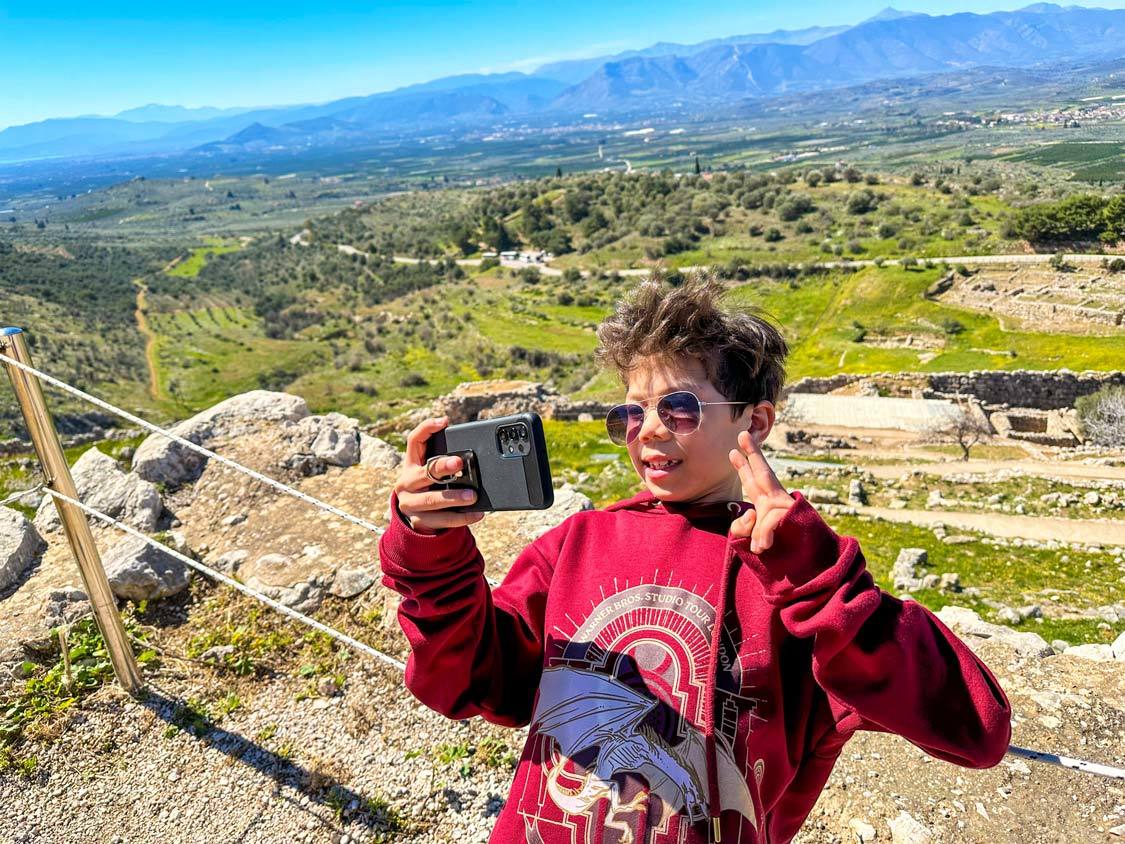
At the top of the ruins of Mycenae is where the Palace of Mycenae once stood. This would have been a luxurious homestead at one point, and the royalty of Mycenae would have shown off all of their best possessions.
While almost all of that is now gone, there is one thing that can never be stolen from the palace.
It’s view!
This was our favorite viewpoint in all of Mycenae. It feels like you can see everything from up here. Dylan even stopped to take his first selfie from the overlook!
Tomb of Clytmnestra
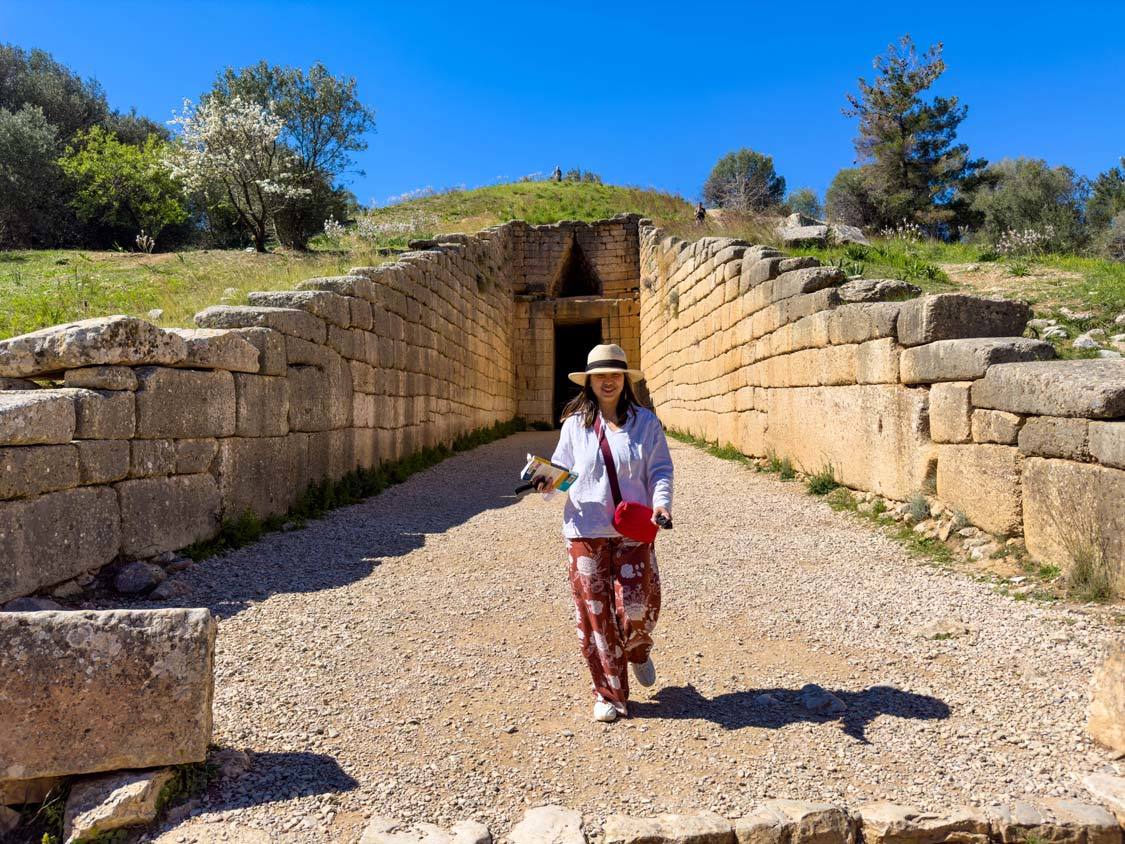
Hidden from view beneath a small hill, we almost missed the Tomb of Clytmnestra when we were visiting Mycenae and the Lion Gate. But while I was taking the boys for their second bathroom break during our exploration, Christina came running up to us with news of another exciting Mycenae attraction that we needed to see.
Supported by a V-shaped set of stone walls, the entrance to the Tomb of Clytmnestra doesn’t reveal just how impressive the inside is. But as we walked through the entrance, supported by a set of massive stones, we could see why this massive vaulted room was deemed appropriate for a queen and all of her jewelry.
Clytmnestra was the wife of the famed Agamemnon and queen of Mycenae during the years of the Trojan War. Agamemnon had callously sacrificed Clytmnestra’s daughter, Ifigeneia. He had brought Ifigenia to him under the guise of offering her as a wife to Achilles. Instead, he sacrificed her to the goddess Artemis, who he believed was preventing the wind from filling the sails of the Greek ships.
When Agamemnon returned, Clytmnestra took her revenge and killed her husband. Their son. Orestes killed his mother in revenge for his father’s death, leading to one of the most important Greek tragedies in history.
Walking around inside, we all felt tiny in comparison to the towering ceilings, And we went around to different spots in the room to test out what our echoes sounded like throughout the tomb.
Grave Circles
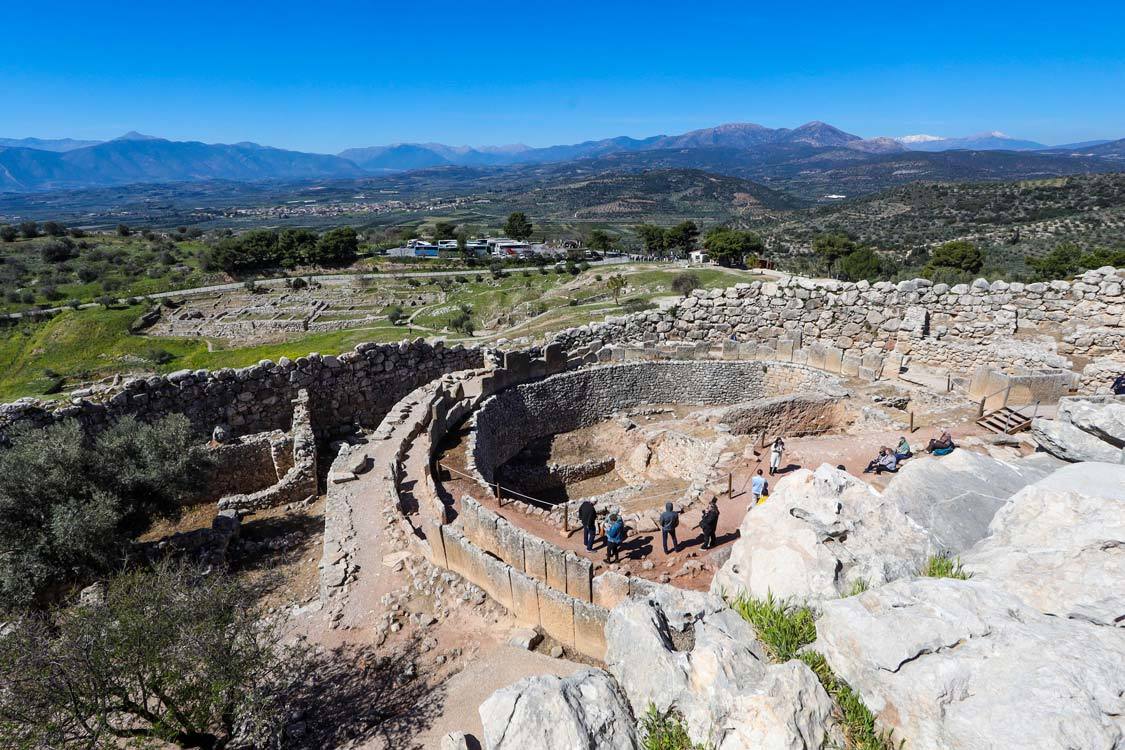
The Mycenaen culture buried their dead outside of the city walls. And if you want to see how they did this, you can check out the Mycenaean grave circles just a short walk from the Lion Gate.
Marked on the Mycenae map as “Grave Circles A and B, these structures made for a pretty unique stop in the city.
Grave Circle A was where the city’s elite were buried. It includes six tombs set aside for members of the wealthiest families. Some of the items found in the graves, such as masks, weapons, and jewelry, are on display in the Mycenae Archeological Museum.
Grave Circle B is much larger. There are 26 tombs here, and each tomb would have held several bodies. There were a few artifacts found in this grave as well, but because the interred weren’t as wealthy, they aren’t as spectacular as those found in Grave Circle A.
Mycenae Archeological Museum
If you really want to dive into the history of Mycenae and the Lion Gate, you’ll want to check out the Archeological Museum of Mycenae. This three-story building is located near the entrance to the ruins and houses findings from excavations made throughout the ruins of Mycenae.
The museum follows the entire 2,800-year history of Mycenae from the Copper Age, around 3,000 BCE, up until Hellenistic time during the second century BCE. One of the museum’s coolest sections showcases some of the jewelry and weapons found in Mycenae. Another can’t-miss exhibit is the Golden Mask of Agamemnon, a golden funerary mask. The one on display at the Mycenae Archeological Site is a copy. The original is on display at the National Archeological Museum in Athens.
Tomb Of Agamemnon | Mycenae Atreus Treasury
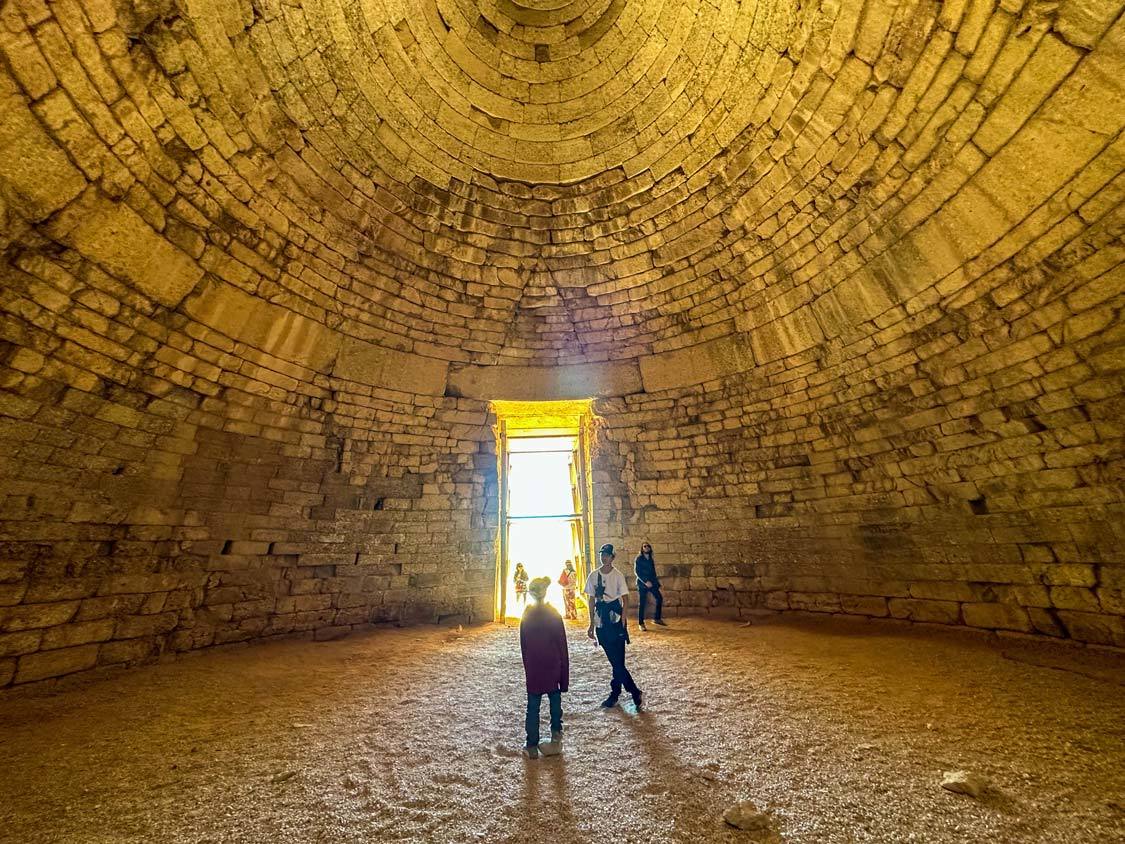
Many visitors to Mycenae and the Lion Gate miss the Mycenae Atreus Treasury when they’re exploring the grounds. Also known as the Tomb of Agamemnon, this ancient vault lies outside of the main archeological site of Mycenae. But it’s easily walkable or accessible via a short drive. The tomb was a quick stop for us as we left Mycenae en route to the ruins of Epidaurus.
The Treasury of Atreus is believed to be the final resting place of the famed Greek leader or his father, Atreus. It’s believed to have been built around 1,250 BCE and was once richly decorated in alabaster and red porphyry, although very little of that is still visible.
The experience is very similar to that of the Tomb of Clytmnestra, but it’s a little bit smaller.
Visiting Mycenae With Kids
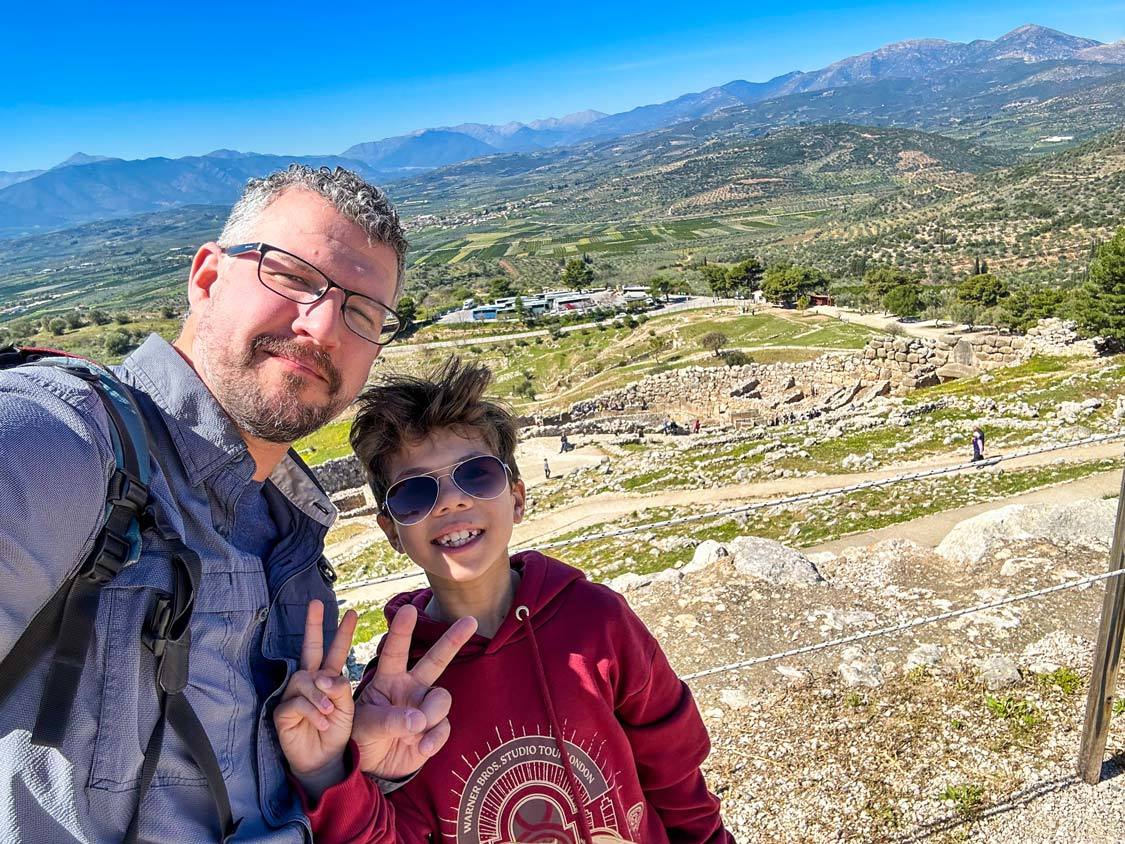
My kids loved their visit to Mycenae. At the time of our family travels in Greece, Dylan was nine, and Cohen was celebrating his twelfth birthday. We were all in awe of the history and the beautiful landscapes that surround the Lion Gate and the ruins of Mycenae.
In combination with the Archeological Museum of Mycenae, there is a lot to learn here, and if your kids have any interest in Greek mythology and history, it’s pretty cool to be in a place where so many familiar names are mentioned.
How To Get To Mycenae
If you’d like to experience the Mycenae Lion Gate for yourself, there are a few options to get there. The first and easiest would be to join a tour from Athens or Nafplio. However, if you’re like us and you’re traveling through Greece on a DIY adventure, I’d recommend driving.
Mycenae By Car
Renting a car is the most popular option, especially if you plan to explore Greece at your own leisure. We had a small van that made a journey through Greece with six people very comfortable.
Getting to Mycenae from Athens is a straightforward drive. You’ll want to take Highway 8 over the Corinth Canal (stop and take a look at this marvel of engineering while you’re at it). From there, it’s about 15 miles (24 kilometers) toward Nafplio. Then, follow the signs toward Mycenae. The entire drive is about two hours.
By Public Transportation
There are regular buses that run between Athens and Nafplio, which include a stop near Mycenae. The bus stop is on Highway 8 near the exit to Mycenae. From there, it’s about a 15-minute walk to the archeological site.
Places To Visit Near Mycenae
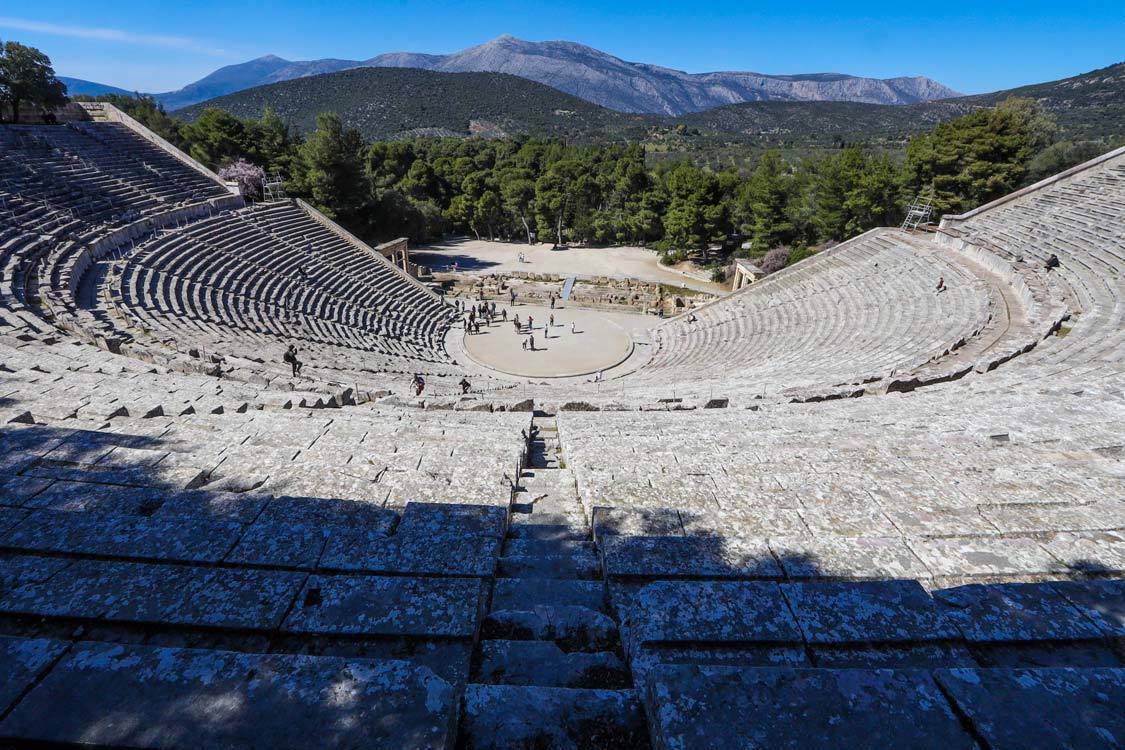
If you’re making a day trip from Athens or looking to extend your travels through the region further, there are a lot of things to see nearby.
For those seeking a hassle-free way to experience all these wonders in a single day, consider joining a guided tour like this one from Viator.
Nafplion
Nafplio was where my family spent the night after visiting Epidaurus and Mycenae. It’s a very cool city that has an atmosphere that combines Venetian and Medieval vibes. The city is topped by the Palamidi Fortress, and offshore of this coastal town is the island fortress of Bourtzi.
There’s great food and absolutely adorable hotels in the town. If you’re staying in Nafplio and want a more intimate experience, consider booking a private tour of Mycenae and Epidaurus. You can read about our time in Nafplio here.
Epidaurus
One of the most famous theaters in Greece lies in the ruins of Ancient Epidaurus. This UNESCO World Heritage Site was famous for its incredible acoustics, and it’s still used for performances to this day. We made the 34-mile (55 km) drive to Epidaurus after exploring Mycenae.
You can read about our visit to the birthplace of modern medicine right here.
Corinth
The city of Corinth was once one of the most important and powerful urban centers in the world. The remains of this city showcase some of the best examples of Roman architecture in the country.
Expand Your Visit Even Further
If you’re looking for an even more epic journey through the heart of ancient Greece, consider this multi-day tour that includes Mycenae along with other must-see destinations. These were, quite honestly, some of the most incredible places that we visited on our road trip through mainland Greece.
You May Also Like To Read:

